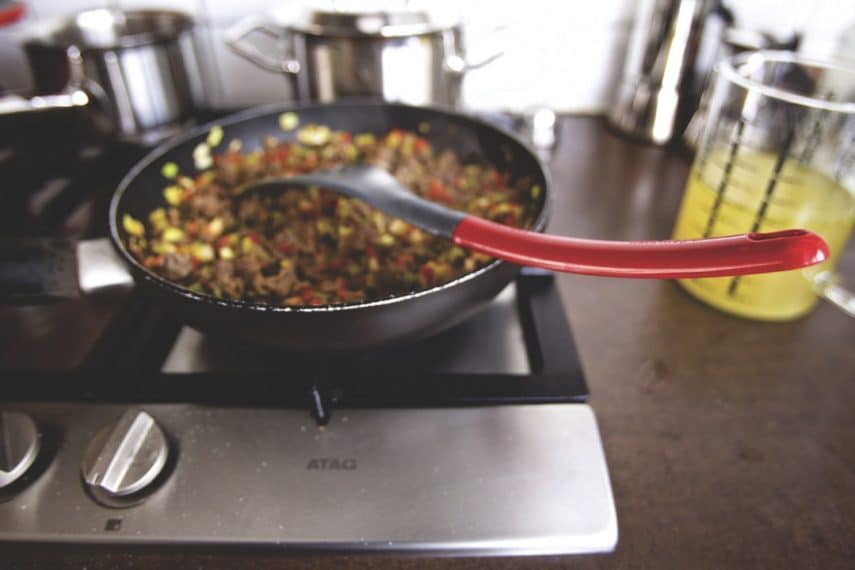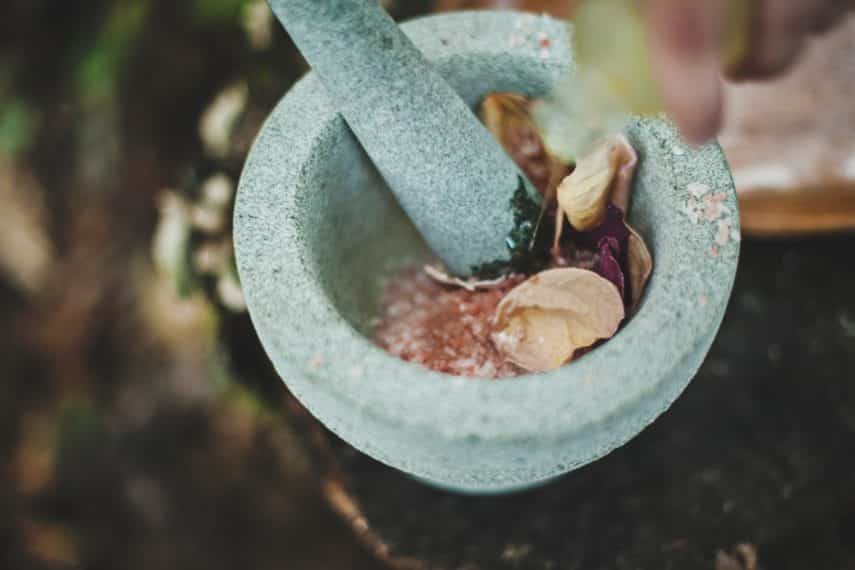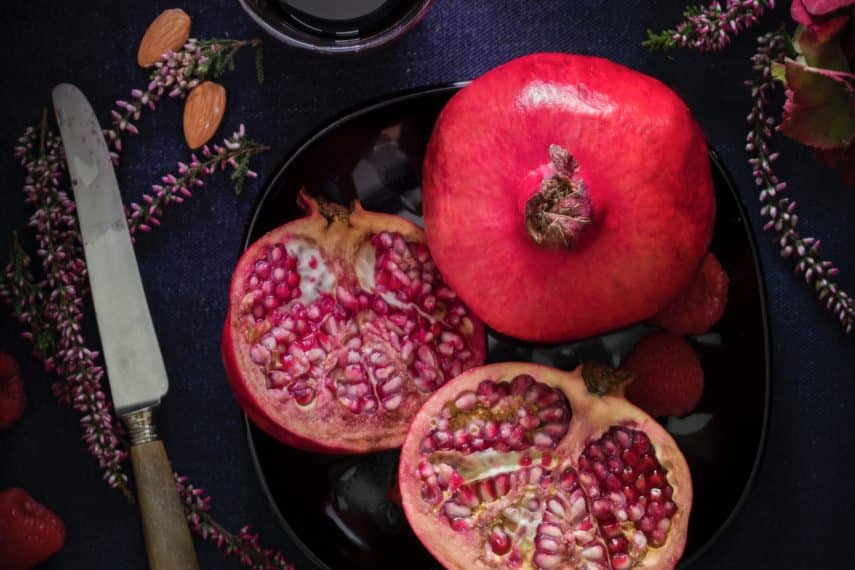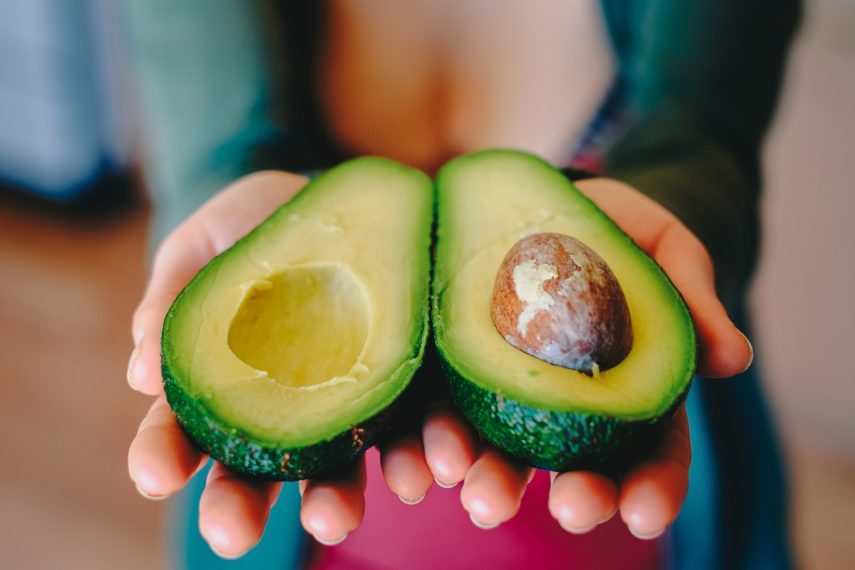This is the fourth article in the IBS and Yoga Series “It’s Your Body!” where we help you explore ways of learning to listen to your body. You can find the introduction here. And all of the articles in the series here. And be sure to read our interview with Kiera.
Yoga and Food
Here, on this website, we find ourselves in a space dedicated to improving our relationship with food and body. Another space that might be similarly dedicated is your kitchen.
What if your yoga practice and your food practice were intertwined? What if they took place simultaneously? How would it feel if one day the distinction ceased to matter, and the separate compartments of your life were fused into one seamless flow of easeful directedness?

Grind Your Own Spices
Let’s start at the very beginning of meal preparation. What an incredible opportunity! It is cost effective, enjoyable, and sense-enhancing to grind your own spices. Find yourself a solid mortar and pestle – they often pop up in thrift stores, or on craigslist –and place it on the floor.
Gather the whole spices you will need, bring them down to the floor within easy reach, and lower your body into a squat. (See the Yoga pose video below to help you learn to squat properly.) Your squat will instantly inform you of several things: the current level of comfort in your gut, the looseness or tightness in your hips, and the length (or lack of length) in your quadriceps. Already you have worlds to revisit in your dedicated body practice!
Grind each spice with care and attention, holding the bowl firmly on the ground between your legs, this position will give you leverage, making the motion unencumbered and gently repetitive. Breathe in the scent that rises from the mortar.

Sensible Senses
If a scent does not sit well with you – don’t put it in your food! Listen to your senses, allow them to inform you the proportions of spice that may taste nice in your mouth and feel good in your body. Engaging your sense of smell will also kickstart your digestive process, increasing the likelihood that this food will be ease-fully handled by your body.
The spices that Monash University have tested and found to be low in FODMAP are plenty! Including freshly dried or ground herbs and spices to your diet will increase your pleasure and well-being. You can find a list of approved spices and herbs here. And be sure to use Monash’s app to ensure you are following their guidelines on amounts.
There are many videos and useful books that go into the history, process and benefit of spice grinding in detail. One excellent book that deeply explores and explains Ayurvedic kitchen practices, including spice grinding and use, is Maya Tiwari’s “The Path Of Practice: A Woman’s Book Of Ayurvedic Healing.” This book will also help guide new eating practices based in awareness of your state of health.

Cut Your Ingredients With Interest and Attention
If you have picked up a knife, the chance is that you are about to slice open some sort of body – animal or vegetable. Be good to your food, and find a sharp knife. It is disrespectful to the integrity of your raw ingredients to use a dull blade. (I’ve also heard some proverb along the way…”To keep a sharp knife is to keep a sharp mind.”…it can’t hurt!) Stand with your weight centered between your feet, and continually check in with your posture, and use of force. Is one shoulder hunched and tense? Does your lower back hurt? Are you clutching your knife? Just noticing will effect a change.
All bodies have lines of energy. If you are cutting vegetables, open up the vegetable on a clear line of energy. Generally, they run horizontally or vertically. Look closely and see which direction the grain of the body runs, and cut cleanly along these lines. For a clear example, try cutting some ginger. From certain directions, the ginger will cleanly slice. From other directions, you will have to saw through fibers and will likely come away with stringy, irregular pieces. If the vegetable is unhealthy or wilted, see if you can figure out why. Likewise, if it is healthy, see how it is you know so.

Muscle and Bone
If you are eating meat, the parallels might be even more profound, and the grains of fiber clearer, and often these run diagonally. See how the muscle connects to the bone, see that a tendon is not just a small connector between muscle and bone, but an extension of connective tissue that envelops the whole muscle and seamlessly interlocks with the bone tissue. This is how your body works as well! How fascinating! Mining other bodies for information about your own can provide a unique perspective that is difficult to obtain given the barrier of skin between our eyes and our insides.
Wash Your Dishes With Your Own Two Hands
As you finish up your time in the kitchen, even if you have a dishwasher, try cleaning the majority of your dishes by hand, in the sink. This will accomplish (at least) three things.
Post-meal body scan: Stand at the sink, weight centered between your feet, and adjust the temperature of your washing water such that it feels like a dreamy bath flowing over your hands. Are you comfortable standing after that meal? Do you want to buckle over? Are you too full to stand? Is breathing uncomfortable? Go through the questions from this and previous articles, and assess the state of your body after this particular meal.
You May Want To Read: IBS & Yoga Series: Activating and Applying Your Self Knowledge for further guidance on how to perform a body scan.
The State of Your Dishes
While it may sound obvious, the state of your dishes is an excellent clue as to the state of your body after this particular meal. It’s probably been about 30 minutes since you cooked, so, how do the dishes look? Are there congealed clumps of fat sticking to every pan?
Is the water you used to cook the green beans brown and unpleasant smelling? Well, this is what your body will look like 30 minutes post meal as well. Is that a pretty image? It might be! There might be delicious smells lingering in your kitchen, and food in the pan that would be perfect for lunch tomorrow, bright liquids that have held beets or some fresh green.
Are your dishes hard to clean? Does it take an inordinate amount of scrubbing to get something clean? Or is it very easy? Is the pan slicked with grease such that it takes 2 or 3 refills of soap on the sponge to un-slick it? What is the remedy? Hot water? More soap? Steel wool? What would be the equivalent for helping these things work through your body?
I don’t mean for all of these to sound negative, or that your body must be suffering if your pans aren’t perfect. But, do let it be more information for you. Are your pans always sticky? Are they greasy? Is your disposal always full of raw vegetables? Your food habits will probably show up in your kitchen in a more obvious way than they will in your body – learn from them!
Interlude to the Next Event
After a meal, you may be accustomed to jumping into the next thing – whatever that is – going to bed, going out for a drink, returning to work. Allow the body a few moments, upright and at rest, to finish the process at hand completely. It sounds very circular (and it is very circular), but if you finish what you start, you will probably have a greater understanding of the entire process that you, your body, undertakes start to finish. This is useful in dealing with a system that mirrors that which takes place in the kitchen. From intake to elimination – stick with your processes.
Keep Practicing!
READ NEXT: IBS & Yoga Series: Identifying Habits









